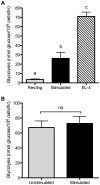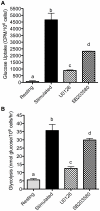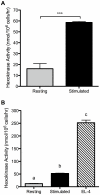Induction of glucose metabolism in stimulated T lymphocytes is regulated by mitogen-activated protein kinase signaling
- PMID: 21085672
- PMCID: PMC2978105
- DOI: 10.1371/journal.pone.0015425
Induction of glucose metabolism in stimulated T lymphocytes is regulated by mitogen-activated protein kinase signaling
Abstract
T lymphocytes play a critical role in cell-mediated immune responses. During activation, extracellular and intracellular signals alter T cell metabolism in order to meet the energetic and biosynthetic needs of a proliferating, active cell, but control of these phenomena is not well defined. Previous studies have demonstrated that signaling from the costimulatory receptor CD28 enhances glucose utilization via the phosphatidylinositol-3-kinase (PI3K) pathway. However, since CD28 ligation alone does not induce glucose metabolism in resting T cells, contributions from T cell receptor-initiated signaling pathways must also be important. We therefore investigated the role of mitogen-activated protein kinase (MAPK) signaling in the regulation of mouse T cell glucose metabolism. T cell stimulation strongly induces glucose uptake and glycolysis, both of which are severely impaired by inhibition of extracellular signal-regulated kinase (ERK), whereas p38 inhibition had a much smaller effect. Activation also induced hexokinase activity and expression in T cells, and both were similarly dependent on ERK signaling. Thus, the ERK signaling pathway cooperates with PI3K to induce glucose utilization in activated T cells, with hexokinase serving as a potential point for coordinated regulation.
Conflict of interest statement
Figures





Similar articles
-
Regulated expression of galectin-1 during T-cell activation involves Lck and Fyn kinases and signaling through MEK1/ERK, p38 MAP kinase and p70S6 kinase.Mol Cell Biochem. 2004 Dec;267(1-2):177-85. doi: 10.1023/b:mcbi.0000049376.50242.7f. Mol Cell Biochem. 2004. PMID: 15663199
-
CD28 costimulation mediates down-regulation of p27kip1 and cell cycle progression by activation of the PI3K/PKB signaling pathway in primary human T cells.J Immunol. 2002 Mar 15;168(6):2729-36. doi: 10.4049/jimmunol.168.6.2729. J Immunol. 2002. PMID: 11884439
-
A p38 MAP kinase inhibitor SB203580 inhibits CD28-dependent T cell proliferation and IL-2 production.Biochem Soc Trans. 1997 May;25(2):304S. doi: 10.1042/bst025304s. Biochem Soc Trans. 1997. PMID: 9191348 No abstract available.
-
Selective induction of p38 mitogen-activated protein kinase activity following A6H co-stimulation in primary human CD4(+) T cells.Int Immunol. 2000 Mar;12(3):253-61. doi: 10.1093/intimm/12.3.253. Int Immunol. 2000. PMID: 10700460
-
Glucose metabolism in lymphocytes is a regulated process with significant effects on immune cell function and survival.J Leukoc Biol. 2008 Oct;84(4):949-57. doi: 10.1189/jlb.0108024. Epub 2008 Jun 24. J Leukoc Biol. 2008. PMID: 18577716 Free PMC article. Review.
Cited by
-
Microbiota-derived acetate is associated with functionally optimal virus-specific CD8+ T cell responses to influenza virus infection via GPR43-dependent metabolic reprogramming.Gut Microbes. 2024 Jan-Dec;16(1):2401649. doi: 10.1080/19490976.2024.2401649. Epub 2024 Oct 10. Gut Microbes. 2024. PMID: 39388633 Free PMC article.
-
γδ T cells acquire effector fates in the thymus and differentiate into cytokine-producing effectors in a Listeria model of infection independently of CD28 costimulation.PLoS One. 2013 May 9;8(5):e63178. doi: 10.1371/journal.pone.0063178. Print 2013. PLoS One. 2013. PMID: 23671671 Free PMC article.
-
Integrating constitutive gene expression and chemoactivity: mining the NCI60 anticancer screen.PLoS One. 2012;7(10):e44631. doi: 10.1371/journal.pone.0044631. Epub 2012 Oct 2. PLoS One. 2012. PMID: 23056181 Free PMC article.
-
Regulating the discriminatory response to antigen by T-cell receptor.Biosci Rep. 2022 Mar 31;42(3):BSR20212012. doi: 10.1042/BSR20212012. Biosci Rep. 2022. PMID: 35260878 Free PMC article. Review.
-
Immune Checkpoint Proteins, Metabolism and Adhesion Molecules: Overlooked Determinants of CAR T-Cell Migration?Cells. 2022 Jun 6;11(11):1854. doi: 10.3390/cells11111854. Cells. 2022. PMID: 35681548 Free PMC article. Review.
References
-
- Cooper EH, Barkhan P, Hale AJ. Observations on the Proliferation of Human Leucocytes Cultured with Phytohaemagglutinin. Brit J Haemat. 1963;9:101–111. - PubMed
-
- Roos D, Loos JA. Changes in the carbohydrate metabolism of mitogenically stimulated human peripheral lymphocytes. I. Stimulation by phytohaemagglutinin. Biochim Biophys Acta. 1970;222:565–582. - PubMed
-
- Sagone AL, Jr, LoBuglio AF, Balcerzak SP. Alterations in hexose monophosphate shunt during lymphoblastic transformation. Cell Immunol. 1974;14:443–452. - PubMed
-
- Culvenor JG, Weidemann MJ. Phytohaemagglutinin stimulation of rat thymus lymphocytes glycolysis. Biochim Biophys Acta. 1976;437:354–363. - PubMed
Publication types
MeSH terms
Substances
Grants and funding
LinkOut - more resources
Full Text Sources
Molecular Biology Databases
Miscellaneous

